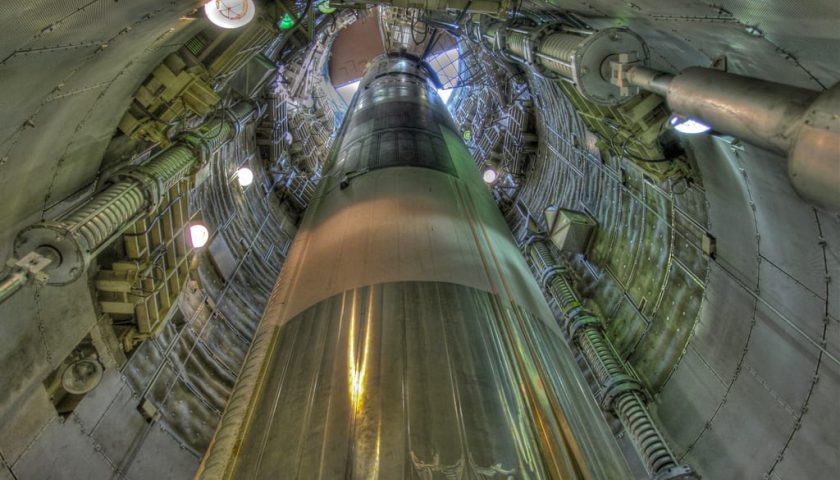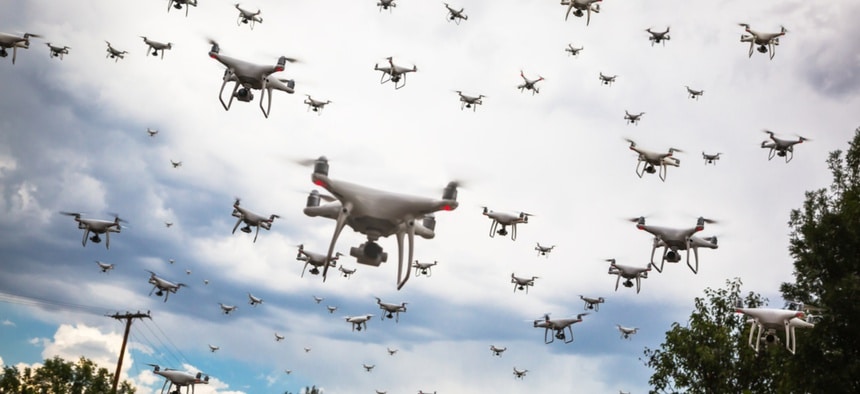While strategic threats are most often associated with weapons of mass destruction, new military equipment and capabilities are redefining the reality, with the emergence of low-lethal strategic threats.
The concept of strategic strike emerged during the Second World War, first through the German blitz against British cities which spanned between the end of the Battle of Britain proper, in September 1940, and May 1941, when the Luftwaffe was redirected eastward in anticipation of Plan Barbarossa.
It was a question, for the German strategists and in particular for Herman Goehring commanding the Luftwaffe, of destroying the will to resist of the British themselves, by striking not only military targets like bases and factories, but also the big cities of the countries, such as London, but also Coventry, Plymouth, Birmingham and Liverpool.
This campaign, which resulted in 43.000 civilian deaths and 90.000 serious injuries, was a failure, the Luftwaffe having lost almost 900 aircraft, including a large part of its bombing fleet, without achieving the intended objectives.
However, this failure did not deter the British and the Americans from doing the same, by carrying out multiple strategic raids by day (US Army Air Force) and night (Royal Air Force) against industrial sites, but also German cities, as well as than certain cities in the occupied zone, causing more than 500.000 deaths in Germany, as many in Japan, with 100.000 dead in Italy and 67.000 killed in France.
The benefits of this Allied strategic air campaign are still under debate, even though they objectively and significantly eroded Axis industrial capabilities and fuel reserves.
However, the explosion of the two bombs in Hiroshima and Nagasaki in August 1945 changed the situation, creating for the first time, by hitting civilian targets, a major strategic effect with the surrender of the Japanese Empire, it is true already in a very bad position after having lost the vast majority of its fleet and the arrival of the Russian divisions engaged in Europe to lead the offensive against the Japanese forces in Manchuria.
However, it is indeed the nuclear weapon which has conditioned the global balance of power since that date, by creating the concept of a weapon of mass destruction, capable of simultaneously destroying the infrastructures and the civilian populations of a large city, for achieve the targeted political objectives, rather than aiming to destroy the enemy's military tool as during the 50 centuries of human history before that.

If the A bomb, then the Hydrogen bomb, constituted the heart of the strategic capabilities of the most powerful nations on the planet, they developed, over the years, other derivative capabilities, such as chemical or bacteriological weapons, or radiation weapons, intended more specifically to destroy populations without destroying infrastructure.
These weapons, brought together in the acronym NRBC for Nuclear, Radiological, Biological and Chemical, constituted the pivot of the strategic balance of power throughout the Cold War, and even beyond. However, for several years, even a few decades, another category of strategic weapons has gradually appeared.
Contrary to the previous ones, these aim not to destroy the populations, but to destroy the infrastructures and the economic and social capacities of a country, to obtain the targeted strategic objective, without crossing the nuclear or similar threshold, by causing the death of millions of civilians.
In this article, we will study the five strategic capabilities corresponding to this classification, which could well change not only the balance of power in the years to come, but also the very logic of strategic threshold and response.
1- Electromagnetic pulse weapons
Of all non-lethal strategic capabilities, the use of electromagnetic pulse weapons is the oldest. Indeed, from the first nuclear explosions in 1945, the consequences of the powerful electromagnetic pulse then generated were studied first by the United States, then, from 1949, by the Soviet Union.
In 1962, the two superpowers carried out experiments in this direction almost simultaneously, with the American project Starfish Prime which detonated a nuclear charge of 1,44 megatons at an altitude of 400 km above the Pacific, and the Soviet project 184 which did the same with less important loads of 300 kt above Kazakhstan.
In both cases, it was above all a matter of neutralizing the adversary's military capabilities over a wide area by destroying all the electronic circuits that were then appearing in military vehicles, ships and aircraft.
On the other hand, at that time, the use as an alternative of nuclear bombs and missiles in the deterrence posture was not even considered, the vulnerability of civilian infrastructures to EMPs being considered too limited.

The situation hardly changed on this subject until the beginning of the 2000s, and the beginning of the global digitization of the economy, but also of the whole of the social life of the countries. At the same time, knowledge around the phenomenon of electromagnetic pulse and its effects had also greatly progressed, so that in 2001, the American Congress launched a study of the vulnerability of the United States to this type of threat, with the creation of the United States EMP Commission.
The first feedback from this commission, in 2004 and especially during a hearing in the Senate in 2005, showed that this type of weapon now represented a strategic threat to the country, not only through their effectiveness on strategic infrastructure such as the electric grid or telecommunications, but also by destroying almost all of the country's transport capacities.
In addition, the commission identified no less than 15 countries, in addition to the United States, which were carrying out experiments in this field, including North Korea, Iran, Russia, China, Cuba, India, Pakistan and Cuba.
Still, the “entry ticket” to acquire such a strategic capability is beyond the reach of the vast majority of countries. Indeed, beyond the non-nuclear electromagnetic pulse weapons which do not have sufficient power to be qualified as strategic, it is simultaneously necessary to have an advanced long-range ballistic capability, as well as nuclear warheads of high power (exceeding 100 kt) and sufficiently miniaturized to take place on board these missiles.
Moreover, even if the major destructive effects of the nuclear weapon employed in such a hypothesis, such as the shock wave and the heat wall, are largely attenuated by the exoatmospheric explosion, such as the radioactive fallout, the victims of such a weapon, like the passengers of the means of transport and the patients hospitalized or dependent on a technology, could convince the targeted country of the “nuclear” and “massive destruction” nature of the attack, and therefore lead to a nuclear response.
However, the threat is considered significant enough to convince the Japanese authorities to bury the command and support capabilities of five of its major military districts, precisely to resist an EMP strike.
2- Drone swarms, from science fiction to strategic threats;
If the use of drones armed with a warhead did not appear during the war in Ukraine, it was during this one that, for the first time, they were used in a massive and coordinated way. to destroy, over time, the adversary's civilian infrastructure.
For this, the Russian armies rely on the Iranian Shahed-136 drone, a device of relatively simple design weighing around one hundred kilos, capable of carrying a military load of 2 kg over 500 km to strike with great precision, thanks to satellite navigation, its target.
These drones have been used by Moscow, alongside more traditional capabilities such as cruise missiles, to destroy Ukrainian energy capabilities, with the aim of triggering a mass exodus of the civilian population to the west, and to bring the authorities Ukrainians to negotiate on unfavorable terms.
For the time being, the volume of Russian strikes has not made it possible to achieve such objectives. The resilience of Ukrainian public opinion seems stronger than ever, as it did for the British during the Blitz.


The rest of this article is for subscribers only
The Classic subscriptions provide access to
all articles without advertising, starting at € 1,99.
Newsletter subscription
Register for the Meta-Defense Newsletter to receive the
latest fashion articles daily or weekly


[…] […]
[…] While strategic threats are most often associated with weapons of mass destruction, new equipment […]